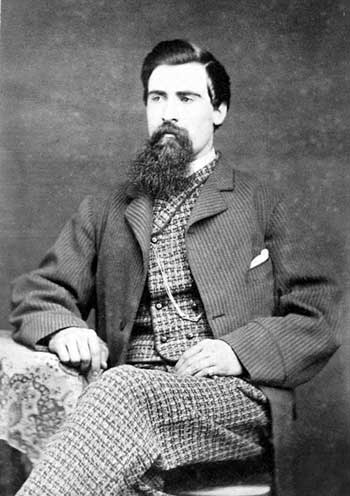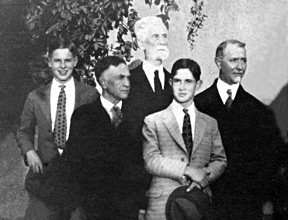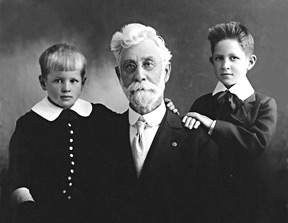 |
 |
| The exact date of the picture of the younger Magee is unknown but it must date from the Civil War or shortly thereafter. The picture of Magee in uniform was taken in California on his ninetieth birthday. | |
Thomas Magee, Regimental Surgeon
 |
 |
| The exact date of the picture of the younger Magee is unknown but it must date from the Civil War or shortly thereafter. The picture of Magee in uniform was taken in California on his ninetieth birthday. | |
Thomas L. Magee was born in Cambridge, Guernsey County, Ohio on October 14, 1836. When he was three years old, his family moved to Peoria County, Illinois. Thomas attended public schools there. He studied medicine at Rush Medical College of Chicago and in Nashville. His medical study was not yet complete when the Civil War broke out.
Career with the Fifty-First Illinois. Magee was mustered into the Fifty-First Illinois on November 25, 1862. His commission as second assistant surgeon was dated November 5. At the time, Jerome Weeks was regimental surgeon, Francis Lytle first assistant surgeon. Magee joined the regiment in Tennessee on November 28, 1862, a month before the Battle of Stone's River, where he was thrown out of his medical studies and into the fire. In the large disarray of the crushing of the right of Rosecrans' right wing and the capture of wagon trains by Confederate cavalry, the hospital supplies of the Fifty-First were lost. Magee lost his black bag. He was pressed into service and put in charge of taking care of Sheridan's wounded—because no doubt he was young, energetic, competent, available, and undaunted. After the Battle of Stone's River, Magee was assigned for a time to the Nashville military hospitals to help in the care of the multitudes of wounded.
Magee was promoted to first assistant surgeon on April 1, 1863, a rank he held only briefly. In Mid-1863, he took a short leave from the regiment to travel to Chicago to appear before an examining medical board. The examination was required for his promotion to the office of regimental surgeon of the Fifty-First. His official appointment as full surgeon of the regiment was dated May 28, 1863.
The Fifty-First Illinois engaged enemies at the Battle of Chickamauga at 4:00 p. m. Within an hour the regiment had more than a hundred casualties. Magee, hospital stewards, regimental musicians, and men who were ill but still walking carried the wounded from the field and tended them behind the lines west of the fields of fighting. Magee worked through the night at the division hospital south of the battlefield at Crawfish Springs. The fighting started again on the morning of the 20th. The shrinking Federal right wing was driven from the field. The partially exposed division hospitals at Crawfish Springs were soon completely exposed. There was a mad rush to evacuate the Federal hospitals; the ambulatory and everyone who could be moved were loaded into ambulances and started off for safer zones. At four in the afternoon, Confederate cavalry took the Federal hospitals. Magee was one of the surgeons who stayed behind with the wounded who could not be moved. He was captured with other physicians, hospital stewards, wounded men, dying men, rations, stores, and hospital supplies. For over a week he tended to the wounded on the Chickamauga field as the Confederates prepared to send their captives off to Richmond or, if they were badly wounded, back across the lines as paroled prisoners. Magee wrote later, "Our supply of rations was only sufficient to last to the fourth day of our capture, when we had to resort to the use of boiled wheat, stored in the building we occupied; and this was the only thing between us and starvation." The men shared tin cups and iron spoons to eat the gruel (Higginson, p. 136). At the very end of September or beginning of October Magee, with his wounded walking charges, marched to Dalton, Georgia and then took the railroad to Atlanta and soon thereafter to Richmond. Magee was imprisoned at Libby Prison in Richmond until November 24, 1863 at which time there was an exchange of physicians, and Magee was "sent north".
Back with the army, Magee served on, not only with the Fifty-First but he was soon promoted to brigade and division surgeon duties—and worked through the 1864 Georgia campaign and then back into Tennessee in November and December 1864 in the effort to thwart John Bell Hood, then finally to New Orleans and Texas. He closed his records with the Federal Medical Department in October, 1865, several weeks after the regiment had been mustered out, left Texas, and gone home.
After the War. After the war Magee returned to Illinois and practiced medicine there. He lived in Prairie City, McDonough County in western Illinois, and there married Sarah E. Sanford on September 19, 1866. They raised three sons: Chester (born 1870), Ernest Delos (born 1872), and Allen Claude (born 1878). In 1883, the Magee family resettled to Riverside, California and then in mid-1885 to San Diego. For years Magee continued the practice of medicine. He served as president of the San Diego County Medical Society and fulfilled various other public-medicine functions: for many years he was "local surgeon for the Santa Fe Railroad in San Diego and he is likewise a trustee of the Agnew Sanitarium of this city. He has served as health officer of San Diego during four different terms and has acted as surgeon of the Ninth Regiment of the California National Guard, being now retired as major surgeon of that military organization. He serves also as secretary of the United States examining board of pensioners for San Diego" (Black, p. 55; full text below). He was a member of the Grand Army of the Republic and past commander of Heintzelmann Post of San Diego.
Sarah Magee died on October 9, 1904. Thomas died on January 1, 1929, one of the longest-lived among his regimental comrades.
Photos: The Regimental Surgeon, Sons, and Grandsons
Top: Thomas Magee and two of his three sons, Chester to the left, Delos to the right, and two grandsons—Chester's sons Byron on the left and Thomas to the right. Delos never married; he was a prominent lawyer in San Francisco. Thomas L. Magee's youngest son Claude is not in the picture. Chester and Claude were both physicians and served in World War I as medical officers. Claude preceded his father in death, dying in 1923 of lung maladies contracted during the war.
Bottom: Thomas Magee and two grandsons: Byron left and Thomas right. Byron died in the Korean War; he received the Silver Star. Thomas lived into the 1980s.
 |
Biographical Sketch of Thomas L. Magee by Samuel Black Samuel T. Black, San Diego County, California: A Record of Settlement, Organization, Progress and Achievement, p. 54-5 Dr. Thomas L. Magee, a prominent physician of San Diego, has here practiced his profession continuously and successfully for more than a quarter of a century. His birth occurred in Guernsey county, Ohio, on the 14th of October, 1836, and when three years of age he was taken by his parents to Illinois, the family home being established in the vicinity of Peoria, in Peoria county. In that city he was reared and educated, attending the public schools. Having determined upon the practice of medicine as a life work, he spent one year in Rush Medical College of Chicago and subsequently entered the medical department of the University of Nashville at Nashville, Tennessee, from which he was graduated in June, 1863. In 1862 he became first assistant surgeon of the Fifty-first Illinois Infantry, acting in that capacity until May, 1863, when he was commissioned surgeon of the same regiment and thus served until the cessation of hostilities between the north and the south. He likewise served as brigade surgeon in charge of the general field hospitals and was mustered out at Port Lavaca, Texas, in 1865. Dr. Magee took part in every battle fought by the Department of the Cumberland except that of Mission Ridge, being at that time in Libby Prison, from October 1 until November 28. At the battle of Stone River he was left in charge of the wounded of Sheridan's division for three days or until the Confederate soldiers evacuated the place. At the battle of Chickamauga he was detailed on the field to take charge of the wounded of Sheridan's division and had the care of them for two weeks or until they were paroled and sent back through the lines. Though often in the midst of danger and death, he fortunately escaped injury. |
In 1865 Dr. Magee returned to Prairie City, Illinois, which remained the
scene of his professional labors until 1883, when he came to California and
located at Riverside. On the 15th of May, 1885, he opened an office at San
Diego and has here followed his profession continuously since, enjoying a
liberal and lucrative practice. His ability has been demonstrated in the excellent
results which have attended his efforts to relieve suffering and restore health
and his standing in the profession is indicated by the fact that he was chosen
president of the San Diego County Medical Society. He served in that capacity
for one year and for a period of sixteen consecutive years held the office of
secretary of the organization. For the past eighteen years he has been local
surgeon for the Santa Fe Railroad in San Diego and he is likewise a trustee
of the Agnew Sanitarium of this city. He has served as health officer of San
Diego during four different terms and has acted as surgeon of the Ninth Regiment of the California National Guard, being now retired as major surgeon of
that military organization. He serves also as secretary of the United States
examining board of pensioners for San Diego.
In August, 1866, at Prairie City, Illinois, Dr. Magee was united in marriage to Miss Sarah E. Sanford, who was a native of New York and passed away on the 9th of October, 1904. To them were born three sons, as follows: Chester Lea, who is a practicing physician of Los Angeles, California; Ernest Delos, an attorney of San Francisco; and Allen Claude, a prominent physician of San Diego. Politically Dr. Magee is a stanch republican. While a resident of Prairie City, Illinois, he served for two years as president of the board of trustees, and for four years he was a member of the board of education. Since a youth of thirteen he has been identified with the Baptist church and for the past quarter of a century has served as deacon of the First Baptist church of San Diego. He is likewise a worthy exemplar of the Masonic fraternity and for eight years served as master of Golden Gate Lodge, No. 248, of Prairie City, Illinois. He was also assistant lecturer of the grand lodge of Illinois. In Grand Army circles he is well known and honored, being past commander of Heintzelmann Post of San Diego and also past commander of D. C. Coon Post of this city. Always approachable and kindly, he is animated by a deep and helpful interest in his fellowmen and is ever willing to encourage and assist those who are working toward higher ideals. |
 |
Sources:
Photographs and family information courtesy of Peter Magee, great-grandson of Thomas Magee. Peter's father was Byron Magee, his grandfather Chester Magee.
Thomas Magee, Compiled Service Record, Records of the Adjutant General's Office, 1780's-1917, Record Group 94, National Archives and Records Administration, Washington, D.C.
Samuel T. Black, San Diego County, California: A Record of Settlement, Organization, Progress and Achievement, Two Volumes. Chicago, The S. J. Clarke Publishing Company, 1913, Vol. 2, 54-5.
Thomas Wentworth Higginson, ed., Harvard Memorial Biographies, Two Volumes, Cambridge: Sever and Francis, 1866, Vol. .7
United States Census.